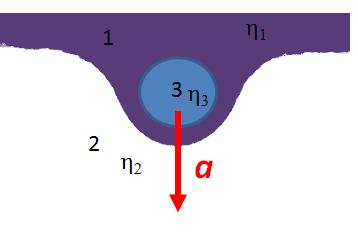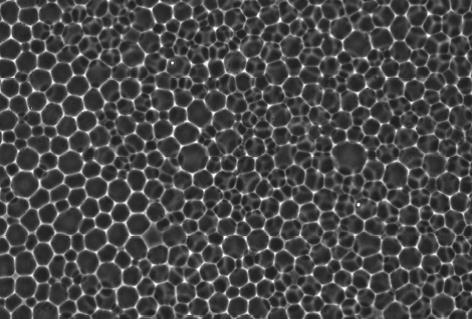Rechercher
Accueil > La Recherche > Axes & Equipes > Matière Molle & Verres > Equipe : Matière Molle > Thème : Physique de systèmes biologiques et biomimétiques
VESICLES AND CAPSULES
publié le , mis à jour le
1. Continuous interface crossing encapsulation (cDICE)
People involved : Laura Casanellas, Martin In (DR), Gladys Massiera (MCF)
Vesicles are spherical lipid bilayers which enclose an internal volume, there are thus used in many applications such as encapsulation, vectorisation or design of biomimetic systems.
We developed and patented [Patent FR0955035, 2009] an original simple method called continuous Droplet Interface Crossing Encapsulation (cDICE), to produce vesicles and more generally capsules controlled in size and content. This method allows the production of vesicles in the range 5-70 µm in diameter and to encapsulate solutions as diverse as micrometric colloids, proteins, cells, viscous solutions (40 mPa.s) or saline solutions (>300 mOsm) [Soft Matter 4610, 2011]. Hemoglobin S (HbS), purified from sickled cell anemia patients can be encapsulated and led to the HbS polymerization at low O2 partial pressure. Vesicles are produced continuously at high frequency (> 150 Hz). We showed that this method allows producing vesicles with membranes composed of an asymmetric bilayer, of lipid mixtures or of copolymers. We are also studying the mechanism of interface crossing by imaging and exploring the role of the lipid in oil composition and structure. For future applications, cDICE has a great potential as a tool for academic research using a biomimetic approach and also for industrial use. Collaborative projects are currently developed in these two directions.

Figure. Scheme of the cDICE principle, cDICE vesicles encapsulating HbS at zero oxygen partial pressure imaged using contrast (left) and in birefringence level (right).
2. MicroBti
People involved : Fanny Giusti (IE CDD), Martin In (DR), Gladys Massiera (MCF)
MicroBti is a project in collaboration with the IRD (MIGEVEC), funded by ANSES which aims to optimize the use of biopesticides for Mosquito control. The goal of the project is to provide a floating formulation of a biolarvicide product to prevent its sedimentation and maintain it where the larvae feed. We hope with this strategy to extend the biolarvicide action and reduce both the cost of application and accumulation in the environment.
Two formulations are proposed based on emulsions and on microencapsulation in a shell made of a low density fluid (oil), based on a capsule production process patented in the Laboratoire Charles Coulomb.

3. EPIC
People involved : Hassan El Itawi (PhD), Jean-Marc Fromental (IE), Martin In (DR), Gladys Massiera (MCF), Ty Phou (IE)
EPIC is funded by the ANR and addresses the industrial scale development of an encapsulation process based on the generation of calibrated droplets of aqueous phase and their coating by crossing a liquid-liquid interface (oil-water). The objective is to produce monodisperse capsules with controlled shell size, thickness and content. The project is based on the process cDICE (Continuous Droplet Crossing Encapsulation), Patent 2010). The use of a centrifugal force allows a large range of flow regimes to be reached when crossing the interface. The concept has been successfully explored for the production of vesicles (cDICE) is now extended to capsules production in the inertia regime. The project investigates the shell formation around the droplet and the stiffening of the shell to produce capsules of controlled thickness, using experimental and numerical tools. The final goal with our partner in Toulouse (LGC) and Nantes (GEPEA) is to build a prototype fulfilling industrial requests in terms of capsule size (chosen ranges from 10 to 1000 microns), shell thickness and productivity (about ten cm3/hour).

4. Microfluidic flow of foam vesicles
People involved : Laura Casanellas (MCF), Gladys Massiera (MCF)
Giant unilamellar vesicles (GUV) are stable objects, with sizes ranging from 1 to 100 micrometers, constituted by a semipermeable bilipidic membrane which enables separating an interior domain from the surrounding media. Unilamellar giant vesicles are used as a unique biomimetic system to model cell compartmentalization, adhesion and mechanical properties of living cells.
We develop a model tissue using an ensemble of adhesive vesicles at high volume fraction (see figure). By tuning the strength of adhesion between neighboring vesicles we can create a cohesive tissue, that we call ¨vesicle foam¨. The microfluidic flow of vesicle foams is studied under different geometries and confinements. Using video microscopy tracking techniques, we measure the spatio-temporal dynamics of the ensemble with the final goal of validating the constitutive equations describing the rheological response of the synthetic tissue.

Fig : Vesicles, produced using the cDICE technique, at high volume fraction (Claudet et al., EPJE 2016).








